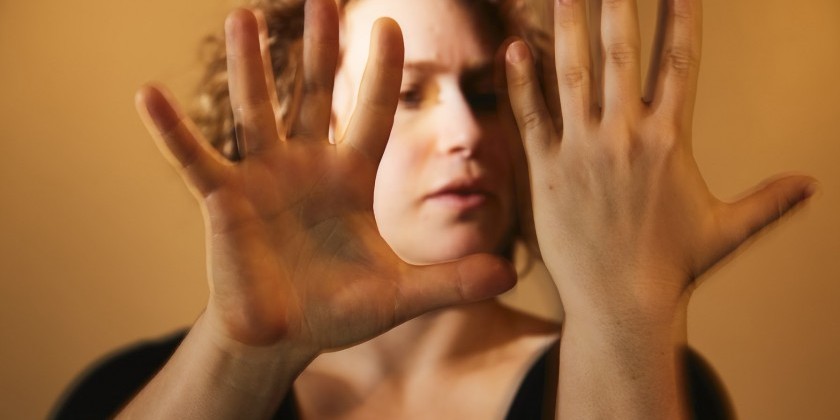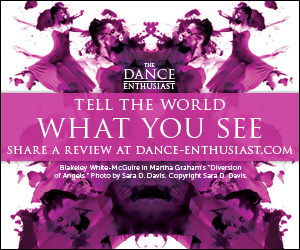The Dance Enthusiast Asks Laurel Snyder about “To What End” at Spectrum

January 10, 2020
Creation, performance, sound design, and costuming: Laurel Snyder
In its Brooklyn location, Spectrum houses experiments in music, art, and ideas. In this case, a quartet of far-out artists: guitarist Javier Areal Velez, trumpeter Chris Williams, cellist Lester St. Louis, and dancer Laurel Snyder. Velez makes his axe sound like a freight train crushing a million glass panels. Williams and St. Louis smush their respective trumpet and cello into buttery, sputtering harmonies.
Snyder defies expectations. Her solo, billed as “movement” on the Spectrum website, exceeds that category by a long shot. She combines lush, kinetic gestures with wild, sweet vocalizations and a disarming stream-of-consciousness narration about identity, growth, and self-presentation.
After the show, I kept thinking about the performative dimensions Snyder explored. The layered spontaneity of To What End was both delightful and mysterious. I wanted to turn the piece inside-out, so I asked Snyder to answer a few questions. Read on for our dialogue.
Dot Armstrong for The Dance Enthusiast: How did you begin? What was the point of entry for this project?
Laurel Snyder: I began working on this project while in residence at Gibney as a Work Up artist in late 2018. I had just completed my first self-produced evening-length work, LOOP, which was a collaboration with musician/composer Adam Schatz and dance artist Emma Judkins. I was processing so much information from that fruitful collaboration and performance, and I allowed myself lots of space and time at Gibney to just see what came out of me vocally, physically, and emotionally. It was a catharsis of sorts after a huge leap in my creative and professional development, and I just had so much to unload. New physicalities, vocal textures, and melodic fragments emerged, and I felt that the work was almost making itself. Obviously, I was making decisions about things, but I wasn’t at all precious about them and was truly pumped to see and hear what was coming out of me.

You performed this at the Wild Project recently, which is a proscenium space; Spectrum is primarily a music venue, with an intimate setup stripped of tech elements. Your work felt very at home in both environments. Does this solo usually have many homes? How do you approach adaptation and re-shaping in solo work?
Laurel Snyder: I generally prefer a more intimate venue, since my work is fairly personal and enriched by the audience’s energetic feedback, but I love the challenge of making proscenium or traditional spaces feel more intimate. I view each new environment as an opportunity to further tune my presence and understand the function and effect of each moment in my performance.
How do you feel about showing work at a music venue? About connecting the experimental music world to the (experimental) dance world?
Laurel Snyder: I often find myself at the crossroads between music and dance. While that can sometimes make me feel like a “jack of all trades, master of none,” I’ve recently found comfort in that balance. The cross-pollination of these mediums is really at the heart of my research, so it’s important that my work is seen in both worlds. The feedback I’ve received in each situation, regardless of whether the viewer is a musician or dancer, has been eerily similar. They might be experiencing the work through a different lens, but what rings true for me is that both are humans navigating similar struggles and successes—being an artist is hard. Being a person is hard, too.
The movement seems to stem from the sound score you create for yourself, creating what appears to be an organic, spontaneous tapestry of choice-making. Tell me more about this relationship in process and performance. How spontaneous are your choices?
Laurel Snyder: I love your words, “spontaneous tapestry of choice-making.” You get it!
The sound design and movement are devised simultaneously, for the most part. It’s important to me that both the live and pre-recorded elements are tethered together from the beginning rather than overlayed afterward to achieve integration, even if there's tension inside that integration. Because the music is developed this way, I generally have a clear sense of the harmonies available and the kind of physicality that either creates or complicates the vocal quality.
That being said, I do rely on the sound design in performance to act as a map that I follow; I’m wary of over-choreographing the live performance elements. I’m curious about how much structure is necessary to create a compelling performance. Can I rely primarily on my improvisational presence and rigor to tune into every moment? There are gestures and spatial orientations that act as landmarks, but again, I try to hold those loosely so I have the agency to change anything I want on the spot if that particular performance requires something different. This enables me to keep hitting the refresh button and asking myself, “Are you present?” And … REFRESH.

This solo dwells in self-perception and complicates ideas about aspiration, growth, honesty, and success. How do you identify yourself on and off-stage? How have you been identified?
Laurel Snyder: I can’t escape my outward appearance as a white, blond, cis woman—that is, indeed, what I am. Sometimes I make lists of all the things that I am: dancer, educator, vocalist, musician, partner, cat-mom ... etc. But these are the things I’m comfortable telling people. With this work, I’m more interested in how my perception and the viewer’s perception of who I am is complicated through my physical and visceral expression. I can’t really control how others see me in my daily life; on stage, I can shed these superficial layers and share what lies beneath because I’ve set up an environment or framework within which I feel safe to do so.
You accompany yourself throughout the entire work—that’s a lot of vocalizing! How do you prepare? How do you maintain your endurance?
Laurel Snyder: Before each performance, I do an extensive vocal and physical warm-up, ensuring that my diaphragm and lungs are ready to support me. It’s important that I release all the tension in my neck to allow freedom throughout my entire structure. I want to feel that no matter where my body ends up, my entire vocal range is always available.
How does this solo converse with/challenge other work you’ve made/are making/plan to make?
Laurel Snyder: I generally like to alternate between solo work and collaborative work to inspire growth, transformation, and reflection. Each solo I make tends to feel like an extension of the one before, marking my artistic progress as I sharpen and clarify my style of making. Each work also tends to reflect my thought process at that particular moment in my life. In that way, these works are somewhat autobiographical, and it’s difficult to predict where my next solo will take me because I’m not sure what my future will hold.

I do intend to begin a new collaboration with musicians Chris Williams and Joanna Mattrey soon. Rather than predict what might come out of our collaboration, I’m excited to see what happens in our rehearsals and shape the work from there. This solo has shown me that I’m primarily interested in the intersection between dance and music and the challenge of accessing an authentic presence in performance. We’ll see where that seed takes me!
What has been the biggest challenge/discovery with this process?
Laurel Snyder: A major challenge has been facing my insecurities in such a public way—in allowing the viewers to actually hear my inner monologue. It’s very scary to reveal so much. I’m also curious about the line between self-indulgence and self-expression. Through this process, I’ve realized that the more personal and authentic I make the work, the more universally it is felt and understood. When I am more vulnerable and honest in performance, perhaps the viewers will recognize some similar thought processes or tendencies and maybe we’ll all feel less alone.
Where do you see this solo in the future? And, any upcoming gigs we should know about?
Laurel Snyder: I’m honestly open to any and all spaces and performance situations because I learn so much from each environment. I plan to expand this work to be a rich 30-minute piece that, ideally, would exist in a split-bill evening.
My next showings are as follows: Saturday, February 15th - Arts On Site Performance Party - I’ll be sharing an excerpt of this work; Monday, June 1st — RECESS at Jonah Bokaer Foundation (formerly Chez Bushwick); Thursday, June 18th — DanceHolo.
Follow me on Instagram @laurelgraces or visit my website www.laurelsnyderdance.com and join my mailing list for teaching and performance updates!











